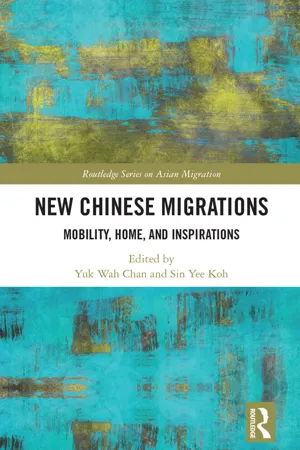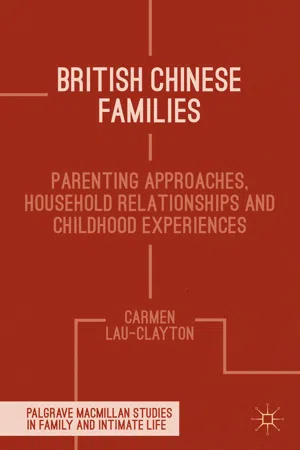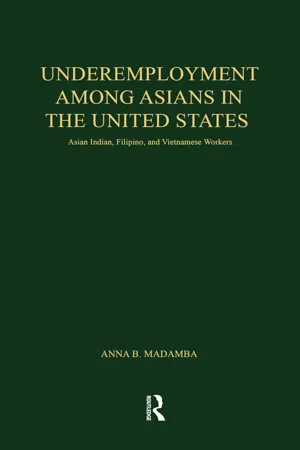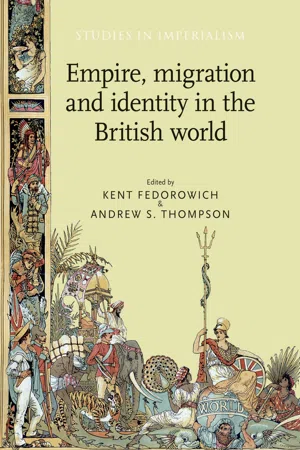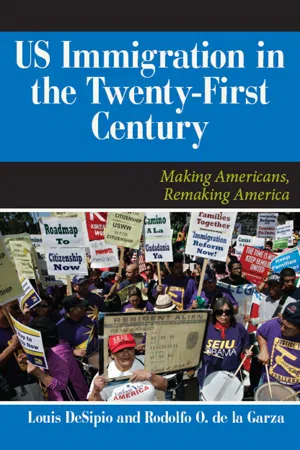Chinese Immigration
Chinese immigration refers to the movement of Chinese people to other countries, particularly during the 19th and 20th centuries. This migration was driven by factors such as economic opportunities, political instability, and the search for a better life. Chinese immigrants faced significant challenges, including discrimination and restrictive immigration policies, but they also made valuable contributions to the societies where they settled.
6 Key excerpts on "Chinese Immigration"
- eBook - ePub
New Chinese Migrations
Mobility, Home, and Inspirations
- Yuk Wah Chan, Sin Yee Koh, Yuk Wah Chan, Sin Yee Koh(Authors)
- 2017(Publication Date)
- Routledge(Publisher)
...Early Chinese migrants were predominantly Chinese males from the southern provinces such as Guangdong and Fujian (Shen, 2012). The economic opening and reforms in China had made freedom of movements possible. Besides facilitating internal migration, the policies also enabled many Chinese people to seek emigration opportunities elsewhere. However, what is significant about new Chinese migration is not only the high numbers of Chinese on the move, but also ‘Chinese migration experiences that are shaped in new ways by global capitalism, globalisation and the rising economic significance of China’ (Thunø, 2007, p. 2). Due to unprecedented economic development in China, more Chinese are migrating from richer provinces and cities rather than from poorer and rural areas (Thunø, 2007, p. 4). Many of the new Chinese migrants, who are predominantly wealthy and well-educated (Xiang, 2016), moved not because they had no choice, but because they aspired to more desirable lifestyles and better economic opportunities available elsewhere. Migration is increasingly pursued by the young Chinese generations for individual development, career advancement (e.g., seeking education abroad and international work experiences), and accumulation of family resources (e.g., making investments and developing transnational connections). Student migration, for example, has become particularly salient (Wang, 2007; Xiang, 2016; Yang, 2016). 5 These movements have also been encouraged by immigration-friendly policies in destination countries that facilitate elite migration. In light of these changes, how can we understand the motivations, processes, and consequences of this new Chinese migration? Secondly, we want to capture the dynamics of Chinese migrations within Asia and the Pacific...
- eBook - ePub
British Chinese Families
Parenting, Relationships and Childhoods
- C. Lau-Clayton(Author)
- 2014(Publication Date)
- Palgrave Macmillan(Publisher)
...Many Chinese individuals at the time remigrated to China or headed towards the West. Western destinations were popular, due to the relaxation of immigration policies during the 1960s (for the UK, United States and Canada) and 1980s (for Australia and New Zealand). Migration from Hong Kong, Taiwan and other Southeast Asian countries often involved well-educated and well-off business people and professionals; the socio-economic backgrounds of Chinese migrants prior to and after the 1960s can be seen to be in sharp contrast (for a more detailed discussion, see Ma (2003) and Skeldon (2003)). In comparison with their predecessors, Chinese migrants after the 1960s enjoyed improved legal status in their new country, due to their more diverse economic and educational backgrounds (Ma 2003). Following China’s decision in 1978 to relax its restriction laws on its citizens moving overseas, Chinese external migration increased substantially from the 1980s onwards (Fang 2000). For example, there was increased governmental support for Chinese students to study abroad in order to modernise China, as a reaction to the country’s ‘brain drain’ problem which arose during the strict communist period. Many who left became permanent residents in their host country (Benton and Gomez 2008). The recent evolutions of movements are not only from China, but also from the peripheral areas of Hong Kong and Taiwan, which are a part of Greater China (Skeldon 1996). The movement of illegal Chinese migrants has been another trend since the 1960s. Some illegal immigrants have left China without the government’s permission; others have gained unlawful entry into the host country; some simply overstay in the destination country or fail to observe the conditions of visitation (Benton and Gomez 2008). Currently, illegal Chinese immigrants have been attracting news headlines and reports worldwide...
- eBook - ePub
- Aaron Ross Powell, Paul Matzko(Authors)
- 2020(Publication Date)
- Cato Institute(Publisher)
...This chapter is not an empirical paper that builds a rigorous model that can be tested. Instead, this format offers an alternative conclusion constructed by informed history and related social science. It is a rough model of human behavior—and a lot of fun. It may not convince you to support liberalized immigration or to believe that the United States and the world would have been better off with a substantially more open immigration policy over the past 130 years; however, I hope it will at least make you think of just how influential immigration has been on virtually every aspect of our nation’s past and how its importance will continue far into the future. Expanding Immigration and Domestic Reforms: 1889–1913 When Congress passed the Chinese Exclusion Act in 1882, the public supported it. Residents in the western states, labor unions, and many other Americans were worried about the growing numbers of Chinese immigrants. So Congress restricted immigration for an entire group of people for no other reason than that they were from a particular country and were not liked by American voters. A previous law in 1875 barred the immigration of criminals and some other specifically defined individuals. But never before was a restriction based on an arbitrary government determination that the population of an entire nation could never become American citizens. The Chinese Exclusion Act was ultimately challenged; the Supreme Court famously overturned it in the case of Chae Chan Ping v. United States in 1889. The Court found that the U.S...
- eBook - ePub
Underemployment Among Asians in the United States
Asian Indian, Filipino, and Vietnamese Workers
- Anna B. Madamba(Author)
- 1998(Publication Date)
- Routledge(Publisher)
...1987; O’Hare and Felt 1991). The long history of Asian immigration to the United States can be traced as far back as the 1800s (Figure 2.2). During the first wave of immigration to the United States, when Europeans comprised the bulk of the immigrants, the first Asian immigrants also started coming (U.S. Immigration and Naturalization Service 1989). Chinese, Japanese, and Indians made up the Asian population in the United States during the mid- to late 1880s. Relatively large numbers of Chinese began immigrating in the early to mid-1880s to cover labor shortages and work on the railroads (Arnold et al. 1987). However, their tendency to keep to themselves and not to assimilate, bred anti-Chinese sentiments, resulting in the Chinese Exclusion Act of 1892 (Bouvier and Gardner 1986) which barred additional Chinese laborers from immigrating to the United States. Figure 2.2 Immigrants to the United States from six major Asian countries: 1820–1990 The Japanese dominated Asian immigration from the late 1880s to 1917 and were also recruited for labor on the farms of Hawaii and California. However, like the Chinese before them, problems of assimilation resulted to a similar exclusionary move, known as the 1907 Gentleman’s Agreement with Japan. In response to the crisis brought about by rising immigration in the face of economic troubles, the Immigration Act of 1917 was passed. One of its provisions was the exclusion of persons from the “Asiatic Barred Zone,” which covered most of Asia and the Pacific Islands (U.S. Immigration and Naturalization Service 1991a). The Quota Act of 1921 installed national origin numerical limits to immigrants from different countries, an approach unfavorable for Asian immigrants (U.S. Immigration and Naturalization Service 1991a). Although Asian immigration has been restricted by United States legislation, a few concessions have also been provided...
- Kent Fedorowich, Andrew S. Thompson(Authors)
- 2015(Publication Date)
- Manchester University Press(Publisher)
...Although Europeans were reluctant to accept such an idea, white settlers increasingly described Asian migration as an invasion by stealth, a view most famously expressed by the writer and politician, Charles Pearson in his book National Life and Character (1893), which used censuses and other ‘hard’ evidence to prove that white supremacy could not be assumed; and that its greatest menace came from China. 29 The Chinese were only 1.75 per cent of the entire New Zealand population in 1870, but 6 per cent of the population in Otago; in an area where the number of white settlers was already almost equal to Maori residents, the Chinese population was seen to tip the balance away from the white population. So despite the small numbers, the colony implemented a series of restrictions from 1881. 30 Even Tasmania and Western Australia, which each had fewer than 1,000 Chinese, passed legislation in 1886 and 1887 respectively, largely in solidarity with their neighbours. 31 Such concerns spread anti-Chinese feelings beyond the working classes to the middle and upper classes which, in turn, put greater pressure on governments to take legislative action. Colonials increasingly came to feel that it was the British government itself which was preventing them from securing their democratic potential. While the majority of residents in the settler colonies were won over to the notion of Chinese exclusion, there was widespread support in Britain for a concept of citizenship which, in theory at least, was racially blind. Indeed, a great deal of the British coverage derogatorily described colonial policies as a product of democracies which allowed ill-informed and hysterically prejudiced working-class people to have political power. This reflected the lack of understanding in Britain about why the Chinese seemed so threatening to their colonial cousins. After all, until the twentieth century, Asians were simply not a physical reality in most Britons’ lives...
- eBook - ePub
U.S. Immigration in the Twenty-First Century
Making Americans, Remaking America
- Louis DeSipio, Rodolfo O. De La Garza(Authors)
- 2018(Publication Date)
- Routledge(Publisher)
...2 Defining Who We Will Be: The History of US Immigration Policy T HROUGHOUT US H ISTORY, C ITIZENS A ND L EADERS H AVE accepted, praised, and revered immigrants. The symbolic notion of a “nation of immigrants” is richly entwined in the mythology of the United States. Intermittently, however, the public has also reacted against immigration and immigrants. Indeed, each of the major periods of welcome and acceptance has been shattered by popular reactions against immigration. Among the most famous reminders of these periods of anti-immigrant sentiment are the Alien and Sedition Acts (1798), the American (“Know-Nothing”) Party (1850s), and the Red Scares at the end of World War I (1919–1920). Another wave of anti-immigrant sentiment began in the mid-1990s, which continues to impede contemporary efforts to craft comprehensive immigration reform. Despite these cycles of long-term acceptance of immigration and periodic anti-immigration fervor, the reverence for immigrants remains strong—reflected in the notion that the United States is a nation of immigrants and that the nation’s success has been and continues to be built on the labor and dreams of immigrants. However, the attacks of September 11, 2001, and the continuing flow of unauthorized immigrants from Latin America and Asia eroded this pro-immigrant sentiment for many Americans (a topic we explore in greater depth in Chapter 3). In this chapter, we examine this seeming contradiction between love of immigrants and periodic opposition to immigration throughout history. We will also look at how this contradiction set the stage for the major ongoing challenge in the creation and implementation of US immigration policy—that is, the twin questions of how many immigrants the nation should admit and what characteristics they should have. These questions were not asked, at least not by policymakers, until the 1860s, when Chinese Immigration began to be limited, culminating in the Chinese Exclusion Act of 1882...
